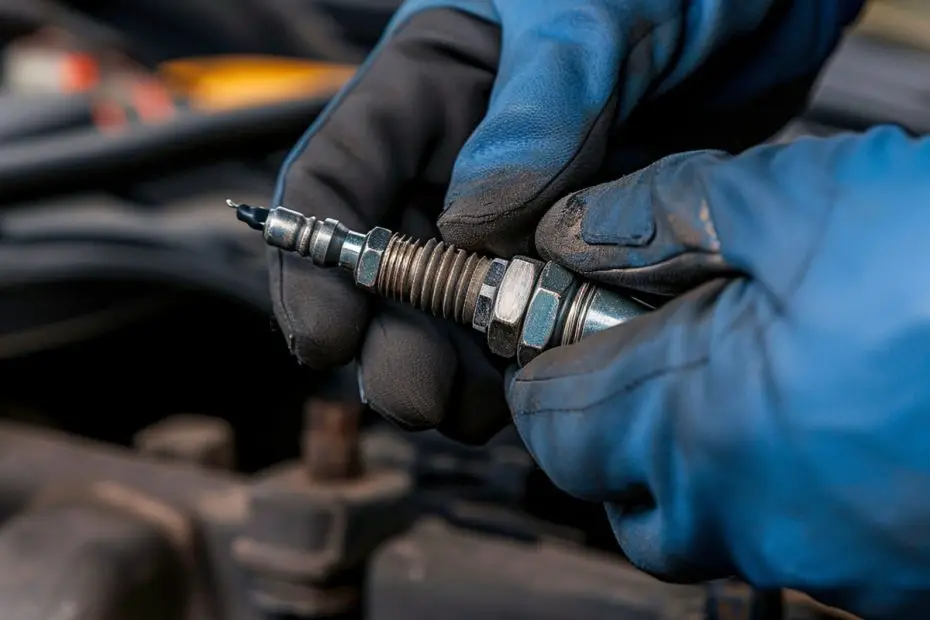Spark plugs are the unsung heroes of our car’s engine, igniting the fuel-air mixture that powers our rides. But when they start to fail, we’re often left scratching our heads, wondering why our car’s performance has taken a nosedive.
We’ve all been there‚Äîdealing with a rough idle, poor fuel economy, or even a car that won’t start. These frustrating issues can often be traced back to a set of worn or faulty spark plugs.
Understanding the signs of bad spark plugs is crucial for any car owner. We’re here to guide you through the common symptoms and how to diagnose the problem, ensuring your vehicle stays in top-notch condition. Let’s dive into the world of spark plugs and get our engines running smoothly again.
Understanding Spark Plugs
Spark plugs are an essential component of a vehicle’s ignition system, serving as the bridge for electrical current to jump and ignite the fuel/air mixture in the combustion chamber. A high-voltage pulse sent by the ignition coil is transformed into a spark that must withstand extreme pressures and temperatures. When operating optimally, spark plugs ensure that our car’s engine runs smoothly and efficiently.
Key Functions of Spark Plugs include:
- Ignition of air/fuel mixture: They’re responsible for igniting the fuel and air mixture in the cylinder, which is crucial for powering the engine.
- Heat transfer: By conducting heat away from the combustion chamber, spark plugs help maintain optimal operating temperatures.
- Ensuring engine longevity: Properly functioning spark plugs promote clean combustion, reducing the likelihood of damaging deposits and engine misfires.

However, their critical role also makes them prone to wear and various issues. Regular maintenance is important, as worn or damaged spark plugs can lead to engine problems, potentially causing our cars to perform poorly or sustain damage over time.
Several Types of Spark Plugs cater to different vehicle needs:
- Copper Spark Plugs: Generally have a shorter lifespan but provide good conductivity.
- Iridium Spark Plugs: Are more expensive but offer better performance and last longer.
- Platinum Spark Plugs: Strike a balance between cost and longevity with good performance.
| Type | Conductivity | Lifespan |
|---|---|---|
| Copper | High | Shorter |
| Iridium | Better | Longer |
| Platinum | Good | Moderate |
It’s important to select the right type based on our vehicle’s requirements and manufacturer recommendations. We must also remember that while spark plugs are durable, they’re not immune to wear. Regular checks can help us identify signs of wear early, such as electrode erosion or carbon build-up, allowing for preemptive action. It’s this proactive approach that can help maintain our vehicle’s health and prevent more serious engine issues down the line.
Common Symptoms of Bad Spark Plugs
Identifying the signs of faulty spark plugs is key to maintaining optimal engine performance. Here’s what to look out for:
- Rough Idling: A telltale sign of spark plug issues is an engine that runs roughly when idling. You might notice unusual vibrations or a jarring sound stemming from the engine, indicating misfires caused by worn spark plugs.
- Engine Misfires: When spark plugs fail to ignite the fuel-air mixture effectively, you’ll experience engine misfires. This can lead to inconsistent performance and increased fuel consumption.
- Trouble Starting: Struggling to start your car could be linked to defective spark plugs. These essential components provide the spark that ignites the fuel mixture, so when they don’t work correctly, your car might not start as expected.
- Reduced Fuel Efficiency: Worn or dirty spark plugs can result in a significant decrease in fuel efficiency. If you’re filling up the tank more frequently, it’s worth checking your spark plugs.
- Lack of Acceleration: If your vehicle no longer responds promptly when you hit the gas, bad spark plugs might be the culprits. They can affect your car’s ability to accelerate efficiently.
- Check Engine Light: The check engine light can activate for numerous reasons, but it’s often related to engine misfires and functioning issues typically linked to spark plugs.

Here’s a simple breakdown of these symptoms in terms of frequency:
| Symptom | Frequency of Occurrence |
|---|---|
| Rough Idling | Common |
| Engine Misfires | Very Common |
| Trouble Starting | Common |
| Reduced Fuel Efficiency | Common |
| Lack of Acceleration | Fairly Common |
| Check Engine Light | Common to Very Common |
To diagnose these issues, a careful inspection of the spark plugs can reveal a lot. Look for physical signs like sooty or worn electrodes, or consult with a professional mechanic who can use diagnostic tools to evaluate spark plug performance. Remember, these components play a fundamental role in the smooth operation of the engine, so we’ll discuss next how to effectively address and fix these issues to ensure that your vehicle remains reliable on the road.
Rough Idle
When our car starts to idle roughly, it’s often one of the first signs that there may be a problem with the spark plugs. A smooth idle is characterized by a steady purr from the engine, indicating that all systems are firing correctly. However, if the idle becomes unpredictable or the vehicle starts shaking, it’s a clear indicator that the spark plugs could be worn or fouled.
Rough idling can manifest in several ways:
- A vibrating sensation that can often be felt through the steering wheel or within the cabin.
- An erratic engine sound where the expected steady rhythm of the engine is replaced by stutters or sporadic revs.
- The sensation that the engine might stall at any moment, which may cause uneasiness when stopped at traffic lights.
When diagnosing rough idle, it’s essential to pay attention to these specific symptoms, as they can point us towards the spark plugs as a culprit. As routine maintenance, we should inspect our spark plugs at regular intervals to catch any early signs of malfunction. Signs of wear or residue buildup on the spark plugs themselves can shed light on the health of our engine‚Äôs inner workings.
To thoroughly check the condition of the spark plugs, we can perform a few simple steps:
- Visual Inspection: Look for any physical damage, soot, or oil on the spark plugs.
- Gap Check: Ensure the gap between the spark plug electrodes is within the manufacturer’s recommended range.
- Resistance Test: A multimeter test can determine if there’s appropriate resistance, confirming spark plug health.
Remember, spark plugs are the guardians of engine harmony. Keeping them in check supports our engine’s longevity and performance, ensuring each ride is as smooth as the last. By understanding and recognizing the signs of a rough idle, we can take proactive steps to maintain our vehicle’s health before small issues escalate into more significant problems.
Poor Fuel Economy
When we notice our car isn’t going as far on a tank of gas as it used to, it may be a symptom of bad spark plugs. Poor fuel economy means the engine is consuming more fuel than it should, which can often be traced back to inefficient combustion. This inefficient combustion can be due, in part, to worn or fouled spark plugs that struggle to ignite the fuel-air mixture properly.

Here are a few reasons why bad spark plugs can lead to increased fuel consumption:
- Incomplete combustion: When a spark plug’s condition is compromised, it may fail to ignite the fuel entirely, which means unburned fuel exits the engine as exhaust.
- Misfires: A misfiring engine due to bad spark plugs forces the engine to mismanage fuel, as the unspent fuel from one misfire requires additional fuel in the next cycle to compensate.
- Engine knock: This can occur when the combustion of the air-fuel mixture is erratic, often caused by faulty spark plugs. This can lead to inefficient engine operation and increased fuel usage.
To determine if spark plugs are indeed the culprit, we can perform a simple inspection. Here’s what we look out for:
- Visual check: Look for any physical damage, soot, or oil contamination on the spark plugs.
- Electrode condition: Verify the integrity of the electrodes and inspect for any excessive wear or deposits.
- Measurement of gap: Ensure the gap between the electrodes is within the manufacturer’s recommended range.
By addressing spark plug issues promptly, we safeguard not only our wallet but also the health of our vehicle’s engine. Regular checks and maintenance are key to keeping spark plugs in good working order and identifying any potential problems before they lead to more significant issues such as poor fuel economy. Remember that the condition of spark plugs can offer vital clues about the overall state of our engine, and early detection of problems can save us from inconvenient and costly repairs down the road.
Difficulty Starting the Engine
When our vehicles experience difficulty starting, it’s hard not to feel a pang of frustration. This common issue might be an indicator of bad spark plugs. A spark plug that’s in good condition is crucial for starting an engine, as it provides the necessary spark to ignite the air-fuel mixture inside the combustion chamber. If the engine cranks longer than usual before starting or simply fails to start, we should definitely consider the possibility that our spark plugs could be at fault.

There are several telltale signs that bad spark plugs might be causing starting troubles:
- The engine cranks excessively long before the car starts.
- Frequent engine misfires upon trying to start.
- A noticeable decline in engine performance right after the car starts.
Why do bad spark plugs make starting an engine a challenge? Well, spark plugs can deteriorate over time for a variety of reasons including:
- Regular Wear and Tear: Spark plugs have a finite lifespan and after many miles, they’ll simply succumb to general degradation.
- Carbon Buildup: Deposits from fuel and oil can accumulate on the plugs, leading to poor conductivity and weakened sparks.
- Improper Gap: Spark plugs need a specific gap between the electrodes to produce a spark; if this gap is incorrect, the spark may be too weak to start the engine.
If we’re dealing with any of these symptoms, we must take action. Here’s a quick checklist of what we could do to diagnose the problem:
- Perform a Visual Inspection: Look for physical damage, wear, or excessive buildup on the electrodes.
- Evaluate the Spark Plug Gap: Confirm that the gap meets the vehicle manufacturer’s specifications.
- Consider the Age of the Spark Plugs: Check against the service interval to see if it’s time for replacement.
Remember, spark plugs are integral to the proper functioning of our vehicle’s engine. If the starting issues persist, we might need to look into other possible culprits like the battery, starter motor, or fuel system. However, starting with the spark plugs is a smart, cost-effective troubleshooting step.
How to Diagnose Bad Spark Plugs
When we suspect our vehicle’s spark plugs might be the culprit behind performance issues, it‚Äôs essential to conduct a thorough diagnosis. Here‚Äôs how we can pinpoint the problem:
- Visual Inspection: Start by removing the spark plug from the engine block. We’re looking for any obvious signs of wear and tear. A healthy spark plug should have a light tan or grayish color. Any abnormalities, like sooty deposits or excessive oil, can indicate an issue.
- Check the Gap: The distance between the center and ground electrodes, known as the gap, is crucial for proper spark plug function. Manufacturers specify an optimal gap for efficient combustion. Use a gap gauge tool to see if it’s within recommended specifications.
- Measure Resistance: With a multimeter, we can measure the electrical resistance of the spark plug. High resistance suggests a likelihood that the spark plug isn‚Äôt functioning correctly. The ideal resistance level varies based on the spark plug type and the vehicle’s requirements.
- Engine Misfire: A misfiring engine often alerts us to a failing spark plug. If we notice sporadic misfires when the vehicle is in use, that’s a strong sign that the spark plugs need attention.

Here’s a snapshot of the diagnostic steps and their outcomes:
| Diagnostic Step | Expected Outcome | Problem Indicator |
|---|---|---|
| Visual Inspection | Light tan/grayish color | Sooty, oily, or overly eroded tips |
| Check the Gap | Gap within manufacturer’s specifications | Gap too wide/narrow |
| Measure Resistance | Resistance within optimal range | High resistance |
| Engine Misfire | Smooth engine performance | Sporadic or consistent misfires |
Performing these diagnostic steps ensures we’re not overlooking some straightforward solutions. Spark plugs are fundamental components, yet they’re relatively inexpensive and easy to replace. Timely maintenance can save us from aggravation on the road and unnecessary expenses in the long run. Given their role in engine performance and fuel efficiency, attending to spark plug maintenance is not just practical‚Äîit’s a matter of preserving the health of our vehicle.
Visual Inspection
When addressing common spark plug problems, one of the most effective initial steps we can take is a thorough visual inspection. This simple, yet crucial process can reveal a wealth of information about the health and functioning of your vehicle’s spark plugs.
Identifying Wear and Tear
Firstly, we’ll want to look for any obvious signs of damage or wear on the plug’s insulator and metal body. Keep an eye out for:
- Cracks or chips in the porcelain insulator
- Burn marks or blistering, which might suggest overheating
- Erosion or heavy wear on the electrodes
These visual cues can often indicate the spark plug’s lifespan is coming to an end and that it’s time for a replacement.
Checking Electrode Condition
Next, it’s essential to examine the electrodes themselves. Ideal spark plugs should have minimal deposits and a proper gap between the center and ground electrodes. Here’s what we’re looking for:
- Excessive carbon deposits, which appear as black soot
- Oily residue, hinting at oil leakage issues
- Ash deposits, generally white and indicative of oil or fuel additives
If the deposits are minor, sometimes they can be cleaned; however, hefty build-up usually means the spark plug is beyond salvage. As for the gap, it should be within the manufacturer‚Äôs specified range; a gap that’s too wide or too narrow can cause ignition problems.
Assessing Coloration and Deposits
The color of the insulator’s tip can tell us a lot about the combustion process. A healthy spark plug will typically have a light tan or gray color. Here are some variations and what they might mean:
- A black, sooty insulator may point to a rich fuel mixture or poor combustion.
- A white, blistered insulator could signify pre-ignition or use of low-quality fuel.
Remember, a visual inspection can guide us to potential spark plug issues, but additional diagnostic tests may be necessary for an accurate assessment. Regular inspections play a key role in the timely identification and resolution of spark plug-related issues, helping us maintain our vehicle’s performance and longevity.
Spark Plug Testing
After we’ve conducted a thorough visual inspection of the spark plugs, we move on to more conclusive testing methods. These tests provide us with a deeper understanding of the spark plugs’ condition and functionality. Spark plug testing involves a few key steps that any car owner can learn to perform with the right tools and a bit of patience.
Resistance Measurement is the first test that we often recommend. Using a multimeter, we measure the electrical resistance of the spark plug‚Äôs firing end. Resistance should fall within a specific range, which is usually outlined in your vehicle’s service manual. Deviations from this range can indicate problems such as a break or a short in the spark plug.
Spark Test provides insight into whether or not a spark plug is firing correctly. We achieve this by removing the spark plug, reattaching the plug wire, grounding the plug body to the engine, and cranking the engine. We’re looking for a strong, consistent spark to be visible. A weak or inconsistent spark could mean the spark plug or the wire may need replacement.
Additionally, we can use specialized Spark Plug Testers which simulate the plug’s operation under pressure, providing us with a clear view of the strength and pattern of the spark across the electrodes. The expected result is a strong blue spark. If the spark is orange or inconsistent, it often points to an issue.
For those who prefer a more data-driven approach, here’s how resistance value ranges typically look for a functioning spark plug:
| Condition | Resistance Range (Ohms) |
|---|---|
| Good | 6,000 – 15,000 |
| Marginal | 15,000 – 30,000 |
| Poor | Above 30,000 |
Lastly, remember to keep the spark plug and the surrounding areas clean during these tests. Dirt or debris can result in faulty readings and further complicate the diagnostic process. Proper testing coupled with regular maintenance ensures our spark plugs perform optimally, which in turn keeps our engines running smoothly and efficiently.
Spark Plug Replacement
After diagnosing bad spark plugs, it’s time to focus on the replacement process. Swapping out old, worn spark plugs for new ones can be the remedy your vehicle needs for better performance and fuel efficiency. Let’s delve into the steps we need to follow for a successful spark plug replacement.

Safety First
Before starting any work on your vehicle’s engine, ensure the engine is cool and the ignition is off. Wearing safety goggles protects our eyes from debris.
Removing Old Spark Plugs
Start by carefully disconnecting the spark plug wires. It’s essential not to tug on the wires themselves but to pull on the boot‚Äîgently twisting can help release them. We’ll then use a spark plug socket with a ratchet to unscrew each plug. It‚Äôs vital to keep track of their order, especially for later reference when installing the new plugs.
- Remove spark plug wire
- Unscrew spark plug with correct socket
- Keep plugs organized
Preparation of New Spark Plugs
Before we install them, we should check the gap on the new spark plugs using a spark plug gapper tool. This ensures we’re within the manufacturer’s recommended settings. We also apply a thin layer of anti-seize on the threads‚Äîthis helps prevent sticking or corrosion, making future changes simpler.
- Check and set the gap
- Apply anti-seize on threads
Installation of New Spark Plugs
Installing the new spark plugs requires precision. We’ll gently thread each plug by hand to prevent cross-threading, and finish with a torque wrench to the manufacturer’s specifications. Reconnecting the spark plug wires securely is the final step in this process.
- Hand-thread spark plugs
- Torque to manufacturer specs
- Reconnect spark plug wires
This should be a procedure we undertake regularly, according to our vehicle’s maintenance schedule. It ensures that our engine runs at peak efficiency and extends the overall longevity of our car.
Monitoring engine performance after replacing spark plugs can give us immediate feedback on our work. If we notice improvements in starting, idling, and acceleration, it’s a good indication that the replacement was successful. Regular checks on these conditions can foretell when our next spark plug change might be due, keeping us ahead in vehicle maintenance.
Conclusion
With the right approach, diagnosing and replacing bad spark plugs is a task we can confidently tackle. We’ve equipped ourselves with the knowledge to spot telltale signs of wear and damage through careful inspection. Remember, following the vehicle’s maintenance schedule for spark plug replacement is key to maintaining engine health. If we’ve done our job well, our engines should be running smoothly, and any previous issues with performance should now be resolved. Let’s keep an eye on engine behavior‚Äîit’s the best indicator that our efforts have paid off.
